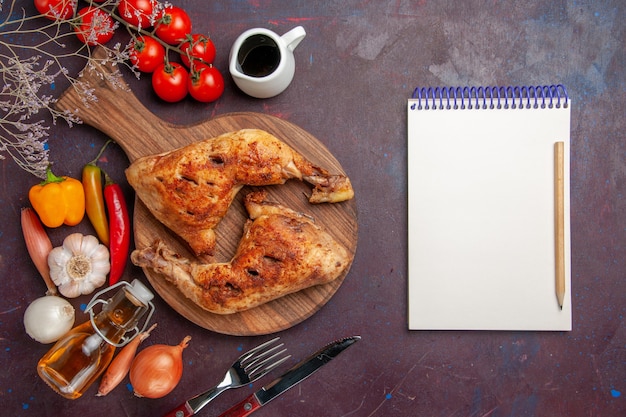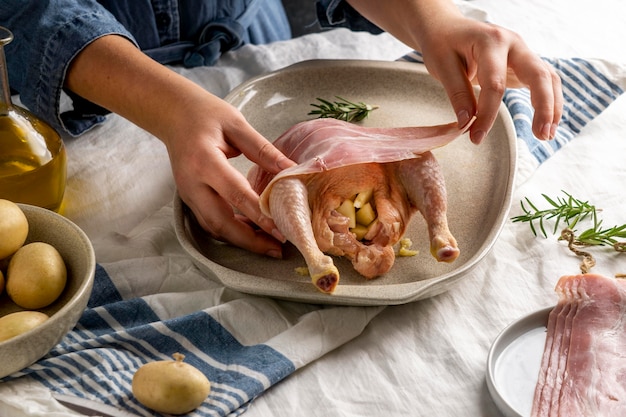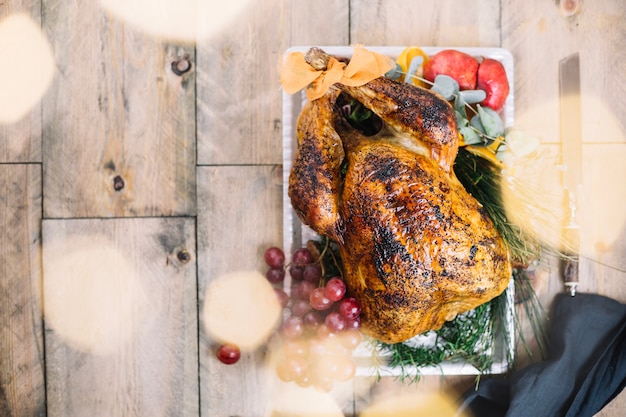There’s something truly magical about cooking a whole chicken. It's a complete meal, perfect for a family dinner or a cozy night in. But the thought of tackling a whole bird can be daunting. What if it turns out dry? What if the skin doesn't crisp up? Don't worry! I've been cooking whole chickens for years, and I'm here to share my foolproof method for achieving perfectly juicy meat and gloriously crispy skin every time. Get ready to impress your loved ones with a delicious roast chicken that’s sure to become a family favorite.
(Part 1) Choosing the Right Chicken

A good roast chicken starts with a good chicken. And I’m talking about quality, not just size. The best results come from choosing a free-range chicken. These birds have more flavor and a better texture. And trust me, you’ll taste the difference.
How to Choose the Perfect Bird
When selecting your chicken, look for a plump bird with smooth, even skin and a good amount of fat underneath. Don’t be afraid of a little fat – it’s essential for keeping the meat moist during cooking. Avoid chickens that have been overly processed, like those with pre-brining or perforated skin. These treatments often interfere with achieving crispy skin.
Preparing the Chicken
Once you have your chicken home, give it a good rinse under cold water and pat it dry with paper towels. Then, remove any excess fat, particularly from the cavity. This will prevent the chicken from becoming greasy while roasting. Now, here’s a tip I learned from my mum: rub the chicken all over with salt and pepper. Season generously! It will make a huge difference in the flavor. I also like to add some herbs at this stage, like rosemary, thyme, or sage. They add a beautiful aroma and depth of flavor.
(Part 2) The Art of Stuffing

Stuffing a chicken is a personal choice, but I find it adds another layer of flavor and creates a visually appealing dish. Plus, it's a great way to use up leftover bread or vegetables! A classic stuffing combines bread cubes, chopped vegetables, herbs, and seasonings. I often add sausage meat or chopped bacon for extra richness. But don’t overstuff the chicken. Just fill the cavity nicely, leaving room for the bird to roast evenly.
My Favorite Stuffing Recipe
I have a secret stuffing recipe that's become a family favorite. It’s incredibly simple, but incredibly delicious. It combines chopped onion, garlic, fresh parsley, breadcrumbs, and sausage meat, all seasoned with salt, pepper, and a generous sprinkle of dried oregano. Everyone always asks for the recipe, and I’m happy to share it:
- Ingredients:
- 1 medium onion, finely chopped
- 2 cloves garlic, minced
- 1/2 cup fresh parsley, chopped
- 1 cup breadcrumbs
- 1/2 lb sausage meat
- Salt and pepper to taste
- 1 teaspoon dried oregano
Instructions:
- In a large bowl, combine the onion, garlic, parsley, breadcrumbs, and sausage meat. Season with salt, pepper, and oregano.
- Mix well until all ingredients are evenly combined.
- Stuff the chicken cavity with the mixture, leaving a little space for the stuffing to expand during cooking.
(Part 3) The Roast: The Key to Juicy Meat and Crispy Skin

Now for the crucial part – the roasting process. The secret to a perfect roast chicken lies in getting the temperature and timing just right. You want the chicken to cook slowly and evenly, so the meat stays juicy and the skin gets gloriously crispy.
roasting time and Temperature
Preheat your oven to 180°C (350°F). This is the ideal temperature for a whole chicken. Place the chicken in a roasting pan, breast side up. You can add some vegetables to the pan too, like carrots, potatoes, or onions. They'll roast beautifully alongside the chicken, and the drippings will create an incredible gravy. Now, the roasting time will depend on the size of your chicken. A general rule of thumb is 20 minutes per pound, plus an extra 15 minutes. So, a 3lb chicken would take about an hour and 15 minutes. But don't rely solely on time!
The Importance of Checking for Doneness
The best way to know if your chicken is cooked through is to use a meat thermometer. Insert it into the thickest part of the thigh, making sure it doesn't touch bone. The internal temperature should reach 74°C (165°F) for safe consumption. If you don't have a thermometer, you can check for doneness by gently pressing the thigh. It should feel firm and the juices should run clear. If you're still unsure, cut into the thickest part of the thigh and check for pinkness.
(Part 4) Achieving Crispy Skin: The Secret to Roast Chicken Success
crispy chicken skin is the ultimate reward for your effort! But how do you achieve that golden, crackling perfection? Here are a few tips:
The Power of High Heat
When the chicken is about halfway through cooking, turn up the oven temperature to 200°C (400°F) for the last 15 minutes. This will help crisp up the skin and give it that beautiful golden brown color.
Basting: The Secret to Flavor and Crispiness
While the chicken is roasting, baste it every 20 minutes with the pan juices. This will keep the meat moist and help the skin to crisp up. You can also use a mixture of melted butter and herbs for basting, which adds extra flavor and helps the skin brown beautifully.
The Importance of Resting
Once the chicken is cooked, let it rest for 10 minutes before carving. This allows the juices to redistribute, resulting in a juicier, more flavorful chicken.
(Part 5) Gravy: The Final Touch
No roast chicken is complete without a delicious gravy. The drippings from the roasting pan are a flavor bomb waiting to be unleashed!
Making a Simple Gravy
Simply pour off the fat from the pan and deglaze it with a little water or wine. Add some flour and whisk it into a smooth paste. Bring to a simmer and add the pan juices. Season to taste with salt and pepper. You can also add herbs or other flavorings to your gravy, such as garlic, onion, or even a splash of Worcestershire sauce.
The Joy of homemade gravy
Homemade gravy is so much better than anything you can buy from a jar. It's simple to make, and it adds a whole new level of richness and flavor to your roast chicken.
(Part 6) Serving Your Roast Chicken: A Feast for the Senses
Once the chicken is rested, carve it and arrange it on a platter. Serve it with your favourite side dishes, like roasted vegetables, mashed potatoes, or a simple green salad. Don't forget to pour the gravy over the chicken and vegetables.
A Feast for the Senses
Take a moment to appreciate your masterpiece. The aroma of the chicken and the beautifully golden skin will be a feast for your senses. And the taste? Well, let's just say you'll be licking your plate clean.
(Part 7) Leftover Love: More Than Just Sandwiches
Let's face it, you're bound to have some leftovers from your roast chicken. But don't think of them as just leftovers! They're an opportunity to get creative and create a whole new meal.
Leftover chicken salad
Combine shredded chicken with mayonnaise, celery, onion, and your favourite herbs. Serve it on crusty bread or crackers for a light and flavorful lunch.
Chicken Soup for the Soul
Use the leftover chicken bones to make a delicious and comforting chicken soup. Simply simmer the bones in water with vegetables and herbs for a few hours. Then, strain the broth and add the leftover chicken, vegetables, and noodles.
Chicken Enchiladas
Dice the leftover chicken and mix it with spices, cheese, and your favourite enchilada sauce. Fill tortillas and bake until golden brown.
Chicken Stir-Fry
Dice the leftover chicken and add it to a stir-fry with vegetables and your favourite sauce. Serve over rice or noodles for a quick and easy dinner.
(Part 8) FAQs: Your Roast Chicken Questions Answered
So, you're ready to tackle your first roast chicken, but you have a few questions? Don't worry, I've got you covered! Here are some frequently asked questions and answers to help you along the way.
FAQs
| Question | Answer |
|---|---|
| How do I know when my chicken is fully cooked? | The best way to check for doneness is to use a meat thermometer. Insert it into the thickest part of the thigh, making sure it doesn't touch bone. The internal temperature should reach 74°C (165°F) for safe consumption. If you don't have a thermometer, you can check for doneness by gently pressing the thigh. It should feel firm and the juices should run clear. If you're still unsure, cut into the thickest part of the thigh and check for pinkness. |
| What if the skin doesn't get crispy? | If the skin isn't as crispy as you'd like, try increasing the oven temperature for the last 15 minutes of cooking. You can also try basting the chicken with a little bit of melted butter or oil to help the skin brown. |
| How do I keep the chicken from drying out? | To prevent your chicken from drying out, roast it at a lower temperature and make sure to baste it regularly with the pan juices. You can also try covering the chicken with a piece of parchment paper or aluminum foil for the first part of the cooking time. |
| Can I roast a frozen chicken? | While you can technically roast a frozen chicken, it's not recommended. Frozen chicken will take much longer to cook, and it's more likely to dry out. It's best to thaw the chicken completely in the refrigerator before roasting. |
| What should I serve with roast chicken? | Roast chicken is so versatile, it goes with a wide variety of side dishes. Some popular choices include roasted vegetables, mashed potatoes, gravy, green salad, and rice. Get creative and experiment with different flavour combinations! |
So there you have it! My foolproof method for achieving juicy, flavorful roast chicken with crispy skin. Now you can impress your family and friends with a delicious home-cooked meal that everyone will love. Remember, it's not about being perfect, it's about enjoying the process and creating a meal that you can be proud of. And who knows, you might even discover a newfound love for roast chicken!
Everyone is watching

Perfect Rice Every Time: The Ultimate Guide to Cooking Rice
Cooking TipsAs a self-proclaimed foodie, I've always been a bit obsessed with rice. It's the foundation of countless cuisi...

Prime Rib Roast Cooking Time Chart: Per Pound Guide
Cooking TipsPrime rib roast. Just the name conjures images of lavish dinners, crackling fires, and hearty laughter. It’s ...

The Ultimate Guide to Cooking Asparagus: Tips, Techniques, and Recipes
Cooking TipsAsparagus. The mere mention of this spring delicacy conjures up images of vibrant green spears, crisp and burs...

Ultimate Guide to Cooking the Perfect Thanksgiving Turkey
Cooking TipsThanksgiving. Just the word conjures up images of overflowing tables laden with delicious food, the scent of r...

How Long to Bake Potatoes in the Oven (Perfect Every Time)
Cooking TipsBaked potatoes are a staple in my kitchen. They're incredibly versatile, delicious, and surprisingly easy to m...
